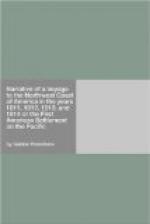During the three years I spent there, the cold never was much below the freezing point; and I do not think the heat ever exceeded 76 deg.. Westerly winds prevail from the early part of spring, and during a part of the summer; that wind generally springs up with the flood tide, and tempers the heat of the day. The northwest wind prevails during the latter part of summer and commencement of autumn. This last is succeeded by a southeast wind, which blows almost without intermission from the beginning of October to the end of December, or commencement of January. This interval is the rainy season, the most disagreeable of the year. Fogs (so thick that sometimes for days no object is discernible for five or six hundred yards from the beach), are also very prevalent.
The surface of the soil consists (in the valleys) of a layer of black vegetable mould, about five or six inches thick at most; under this layer is found another of gray and loose, but extremely cold earth; below which is a bed of coarse sand and gravel, and next to that pebble or hard rock. On the more elevated parts, the same black vegetable mould is found, but much thinner, and under it is the trap rock. We found along the seashore, south of Point Adams, a bank of earth white as chalk, which we used for white-washing our walls. The natives also brought us several specimens of blue, red and yellow earth or clay, which they said was to be found at a great distance south; and also a sort of shining earth, resembling lead ore.[V] We found no limestone, although we burnt several kilns, but never could get one ounce of lime.
[Footnote V: Plumbago.]
We had brought with us from New York a variety of garden seeds, which were put in the ground in the month of May, 1811, on a rich piece of land laid out for the purpose on a sloping ground in front of our establishment. The garden had a fine appearance in the month of August; but although the plants were left in the ground until December, not one of them came to maturity, with the exception of the radishes, the turnips, and the potatoes. The turnips grew to a prodigious size; one of the largest we had the curiosity to weigh and measure; its circumference was thirty-three inches, its weight fifteen and a half pounds. The radishes were in full blossom in the month of December, and were left in the ground to perfect the seeds for the ensuing season, but they were all destroyed by the ground mice, who hid themselves under the stumps which we had not rooted out, and infested our garden. With all the care we could bestow on them during the passage from New York, only twelve potatoes were saved, and even these so shrivelled up, that we despaired of raising any from the few sprouts that still gave signs of life. Nevertheless we raised one hundred and ninety potatoes the first season, and after sparing a few plants for our inland traders, we planted about fifty or sixty hills, which produced five bushels the second year; about two of these were planted, and gave us a welcome crop of fifty bushels in the year 1813.




